The best phones in 2024: our 15 favorite smartphones right now
This article contains affiliate links; if you click such a link and make a purchase, Digital Trends and Yahoo Inc. may earn a commission.

Choosing the best phone in 2024 can be challenging with the multitude of excellent options available. Whether you are an iPhone fan, an Android user, or open to any smartphone, finding the perfect one may seem overwhelming. But don't worry, we're here to help!
Below, we've compiled a list of our top picks for the best phones currently available. We believe there's something for everyone on this list, and we're confident that you'll find a phone that suits your preferences perfectly.
If you have specific preferences, check out our picks for the best Android phones and the best iPhones. Otherwise, keep reading to see what we think are the best phones in 2024.

Apple iPhone 15 Pro Max
The best iPhone
Pros
Titanium design is a huge upgrade
The Action button is excellent
Outstanding camera system
Virtually perfect display
Blazing-fast performance
iOS 17 is great (especially StandBy)
USB-C port is convenient
Cons
Slow USB-C charging speeds
Only one way to use the Action button
Disappointing battery life
Why you should buy this:The iPhone 15 Pro Max has every feature imaginable — the most on any iPhone today.
Who it’s for: Anyone who wants the best iPhone currently on the market.
Why we picked the iPhone 15 Pro Max:
Until recently, the regular iPhone models and the “Pro” variations were not significantly different. However, the new iPhone 15 Pro series — particularly the 6.7-inch iPhone 15 Pro Max — has fantastic features that can only be found on these most expensive models. The new titanium body is just the beginning, and the camera features vary even between the Pro and Pro Max models.
Our favorite iOS phone, the iPhone 15 Pro Max, is available in Natural Titanium, Blue Titanium, White Titanium, and Black Titanium. Each offers a matte glass back and smaller bezels around what continues to be an always-on Super Retina XDR display with a 120Hz refresh rate.
The iPhone 15 Pro series has undergone significant hardware changes compared to previous models, including a switch from stainless steel to titanium and ghe additions of a USB-C port, an Action button, an A17 Pro chip, and improved cameras. With the new USB-C port, you no longer need to use Lightning cables, making it more convenient if you have a recent iPad or any other electronic device that uses USB-C. This switch also means quicker file transfer speeds, although it doesn’t necessarily result in improvements on the charging side. Apple promises the same 50% charge in 35 minutes using a 20-watt adapter.
At first glance, it may seem like nothing has changed with the iPhone 15 Pro Max’s camera system. The device still has a 48-megapixel (MP) main camera, a 12MP ultrawide camera, and a 12MP telephoto camera featuring apertures of f/1.78, f/2.2, and f/2.8, respectively, which is identical to the specs of its predecessor, the iPhone 14 Pro Max. However, some notable differences have a significant impact on the user experience.
For starters, the main camera of the iPhone 15 Pro Max now takes 24MP shots by default instead of 12MP, resulting in more detailed images. Additionally, Apple's latest Smart HDR 5 image processing technology enhances the colors of the photos. Finally, the telephoto camera of the iPhone 15 Pro Max now supports up to 5x optical zoom, which is an improvement over the previous maximum of 3x.
It's big and expensive, but if you want the very best smartphone running Apple's iOS operating system, the iPhone 15 Pro Max is the one to get.
Apple iPhone 15 Pro Max
The best iPhone

Apple iPhone 15
The best iPhone runner-up
Pros
Big camera upgrade
USB-C
Matte glass feels incredible
Dynamic Island
Curved edges are more comfortable
Reverse wired charging
Cons
60Hz refresh rate display
Most color options are too light
Can get warm when running intensive apps
Won't get Apple Intelligence in iOS 18
Why you should buy this: It's Apple's latest and greatest iPhone.
Who it’s for: Anyone would needs an iPhone upgrade, but doesn't want to go the Pro route.
Why we picked the iPhone 15:
For those who don't require all the advanced features of the more expensive iPhone 15 Pro series, the all-new iPhone 15 is a great option. This flagship device by Apple comes in five colors: pink, yellow, green, blue, and black. It has a 6.1-inch Super Retina XDR display like its predecessor, as well as several new features that make it worth considering, starting with the Dynamic Island.
The Dynamic Island, first introduced on the iPhone 14 Pro series, is a fun new way to view notifications, Live Activities, and more. If the Dynamic Island isn't enough to persuade you to consider the iPhone 15, take a look at its new camera system.
The iPhone 15 has significantly upgraded its camera game this time with a 48MP primary camera and a 12MP ultrawide lens with a wide 120-degree field of view (FoV) that can capture your memories in breathtaking detail. However, the ultrawide lens has remained unchanged from the previous generation and still lacks an autofocus feature. The selfie camera still delivers stunning results, but it is also unchanged at 12MP.
Unlike the iPhone 14 Pro models that only allowed shooting in 48MP full resolution with ProRAW and defaulted to 12MP for regular photos, the iPhone 15 now defaults to 24MP photos. You can switch it back to 12MP to save storage space, but the 24MP photos are worth the extra space as they look remarkable overall and the minor size difference is negligible. The new camera features will help you capture every moment in stunning detail and relive them for years to come.
USB-C has replaced Lightning in the iPhone 15, bringing quicker transfer speeds between devices, but no charging speed improvements. Connecting the iPhone 15 with at least a 20W adapter gets you about 50% charge in 30 minutes, which is the same as before.
The iPhone 15 still only supports a 60Hz refresh rate, which is unfortunate for a smartphone in 2023. This limitation negatively affects gaming and web-browsing experiences for users with quick fingers. It should also be noted that the iPhone 15 comes with the older A16 Pro chip. This isn't bad, but you aren't getting the latest and great chip Apple has to offer on a smartphone.
Apple iPhone 15
The best iPhone runner-up
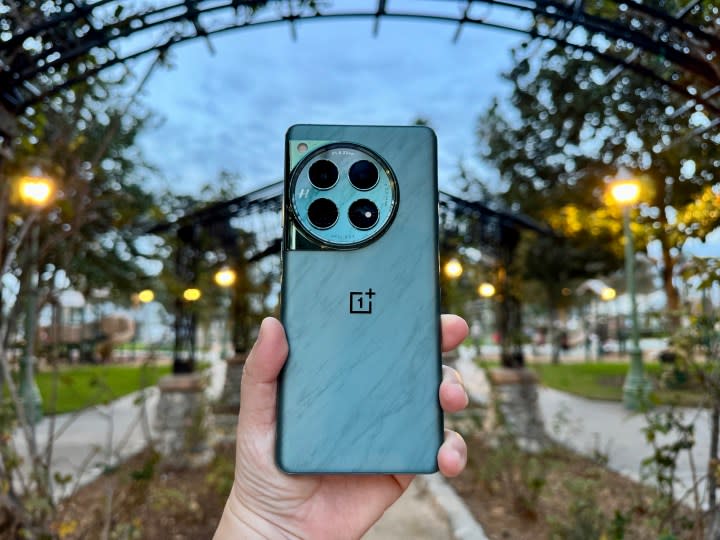
OnePlus 12
The best Android phone
Pros
Beautiful curved display
Flowy Emerald is a truly unique color
Powerful performance
Hasselblad camera system delivers great results
Two-day battery
Very fast wired and wireless charging
Cons
Back glass is slippery
Curved screen has some annoyances
Large size can be unwieldy
Why you should buy this: It's a show-stopping premium flagship at the price of a regular flagship.
Who it's for: Anyone looking for the best Android has to offer.
Why we picked the OnePlus 12:
While OnePlus never really went away, it had been pushed into the shadows by strong offerings from Samsung and Google. Well, that period has ended, as OnePlus is back, and the OnePlus 12 is one of the best smartphones you can buy — period.
It's not fair to describe most current phones as featureless slabs, but next to the OnePlus 12, they might as well be. This phone is distinct, with a beautiful green design, gently sloping sides, and one of the more unique-looking camera systems we've ever seen on a smartphone. There's a strong family resemblance with the OnePlus Pad, and it looks great. It feels good, too, but be advised it's a slippery phone — a case is highly advised.
That premium feeling extends to the display. The OnePlus 12 has a 6.8-inch LTPO AMOLED display, running a 1440p resolution (for a crisp 510 pixels per inch), with a 120Hz refresh rate. If that isn't enough, it also gets bright enough to be visible on the surface of the Sun, thanks to a peak brightness of 4,500 nits. Frankly, that's a little ridiculous and enormously overkill, as most other flagships sit around the 2,000 nits mark, and those are fine. But "overkill" was clearly what OnePlus had in mind, as the phone's other specs are way, way beyond what they need to be.
We'll start with the most reasonable part of the spec sheet: The Qualcomm Snapdragon 8 Gen 3. Qualcomm's latest processor is incredibly fast, and it won't shy away from any app or game you care to run on your big screen. It's a stupendously powerful piece of kit, so when we say it's the most understated part, you know OnePlus isn't messing around. First comes the storage options, which start at 256GB and go up to 512G. RAM is where things get really bonkers, with the base model getting 12GB. That's the same amount as the Samsung Galaxy S24 Ultra — and it only gets higher from there. Upgrade the storage, and you get a boost in RAM, too, up to 16GB.
The camera system is a little toned down, at least compared to the RAM specs, but not by too much. The rear camera system comprises a 50MP main lens, a 64MP periscope telephoto with a 3x optical zoom, and a 48MP ultrawide lens, and there's a 32MP selfie camera around the front. It's a solid suite, and it takes good photos with realistic colors. Portrait shots can be a little lacking, and it sometimes struggles with moving subjects in low-light photos, but these are relatively small negative points.
The OnePlus 12 runs Android 14, under the Oxygen OS 14 skin, and it's a great piece of software, clear and uncluttered. OnePlus has promised five years of updates, which is a good, if not stellar, promise.
Finally, we'll touch on the battery life. It is, in a word, excellent. You can expect two days of battery life from the 5,400mAh battery with moderate use, and since the recharging is super fast, it won't spend long on the charger either. Wired charging goes up to 80W, while the 50W wireless charging is faster than most flagship phones' wired charging. There's even reverse wireless charging up to 10W.
The OnePlus 12 is a certified premium flagship killer, albeit at a flagship price. It starts from $800, putting it on a level basis with the Samsung Galaxy S24 while offering specs on a level with the S24 Ultra. It's an incredible piece of tech and absolutely our pick for the best Android phone you can buy today.
OnePlus 12
The best Android phone
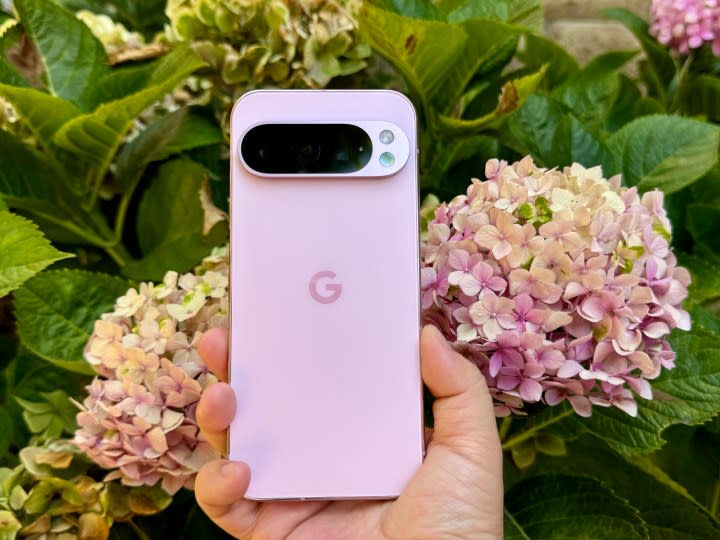
Google Pixel 9 Pro
The best Android phone runner-up
Pros
Beautiful hardware and display
Compact size without compromises
It's pink!
Long battery life
Great cameras
Mostly good AI tools
Seven years of updates
Cons
Slow charging speeds
128GB base storage
Why you should buy this: It's the perfect Android phone for someone looking for a smaller handset.
Who it's for: Anyone who wants a top-tier smaller Android phone that isn't made by Samsung.
Why we picked the Google Pixel 9 Pro:
Our Google Pixel 9 Pro reviewer likes this phone so much that she’s considering ditching her iPhone. Yes, a long-time iPhone owner is considering heading over to Android.
This phone checks all the boxes — it has a beautiful compact size, a premium feel, an exceptional camera system with 5x optical zoom, and even a gorgeous rose quartz colorway.
The Google Pixel 9 Pro features a 6.3-inch Super Actua OLED display with a 120Hz refresh rate and comes in hazel, obsidian, and porcelain. Like other phones in the Pixel 9 series, it also includes a newly designed camera shelf that no longer extends to both sides of the phone. It’s an impressive look that is completely different, but it does not detract from the Pixel style Google has perfected over the years.
But there’s more. Unlike previous Pixel models, this one is praised for its long battery life, lasting about 24 hours between charges while performing everyday tasks. The fastest wired charging speed here is 27W, which allows you to get a 55% charge in about 30 minutes and just over an hour for a full charge.
The Pixel 9 Pro also includes one free year of Google Gemini Advanced and gives you seven years of software updates.
If you love this phone but would prefer a larger display, you’re in luck. Google has resurrected the XL label for the Pixel 9 Pro XL. This big phone includes all the great features of the regular Pro model but with a 6.8-inch Super Actua display. That phone also offers wired charging of up to 37W.
With the Pixel 9 Pro, Google gave small-phone lovers a pro-level experience without compromise.
Google Pixel 9 Pro
The best Android phone runner-up
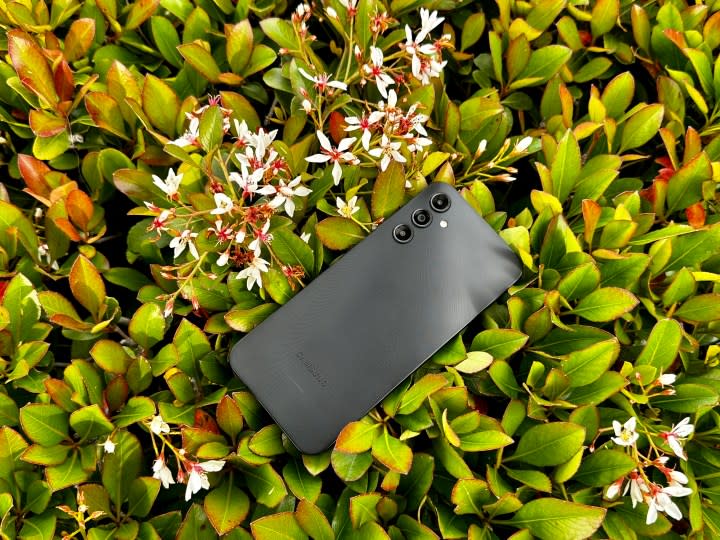
Samsung Galaxy A14 5G
The best cheap phone
Pros
Only $200
Large display with a 90Hz refresh rate
5,000mAh battery
50MP rear camera, 13MP selfie camera
Respectable performance
Unique, textured back
Cons
Secondary cameras aren't impressive
No water or dust resistance
Fast charging up to 15W only
Why you should buy this: The Samsung Galaxy A14 5G looks good and packs a punch for a budget price.
Who it’s for: Buyers on a budget looking for a safe, sensible choice that won't disappoint.
Why we picked the Samsung Galaxy A14 5G:
Are you on a budget but want great value? Then you can't go wrong with Samsung's A-Series phones, which are excellent for the price. The Galaxy A14 5G is one of the latest entries in the family, and it's well worth your attention.
With the Galaxy A14 5G, you get a large, 6.6-inch LCD display that has a 1080p resolution with a 90Hz adaptive refresh rate. Though you do get some bezels around the display, the screen itself looks nice, has vibrant colors, and you get relatively smooth scrolling with the 90Hz refresh rate. The design of the phone itself is simple and minimalistic, and the plastic back has a unique texture that helps give you more grip than the glass on most phones.
The A14 5G has 4GB of RAM and a MediaTek MT6833 Dimensity 700 chip. So while it's not packing the newest Snapdragon 8 Gen 2, it has decent performance for the price. You may notice a tiny bit of stutter when navigating the phone's interface or opening up apps, but considering that the phone is just $200, it's expected. It only comes with 64GB of storage, but that can expand to 1TB through a microSD card. Samsung ships the A14 5G with Android 13 and OneUI 5, and you will get two major Android upgrades and four years of security updates. For $200, you're getting a good amount of longevity, especially considering that this phone is 5G-capable.
The camera is also quite impressive, as you get a 50MP main shooter, with a 2MP macro and 2MP depth sensors. Thanks to the MediaTek chip, taking photos is fast and the results are quite good for a $200 phone. When the phone was used to capture some in-motion shots of a child, the results came out quite well. Colors are also bright and punchy, like most of Samsung's other higher-end phones.
And lastly, though the Galaxy A14 5G doesn't have wireless charging, it does have a massive 5,000mAh battery that will last at least two days with regular use. But wired charging caps out at 15W, so it's a little slow. However, considering how much use you'll get from a single charge, you may not be having to plug it in every night.
Samsung Galaxy A14 5G
The best cheap phone
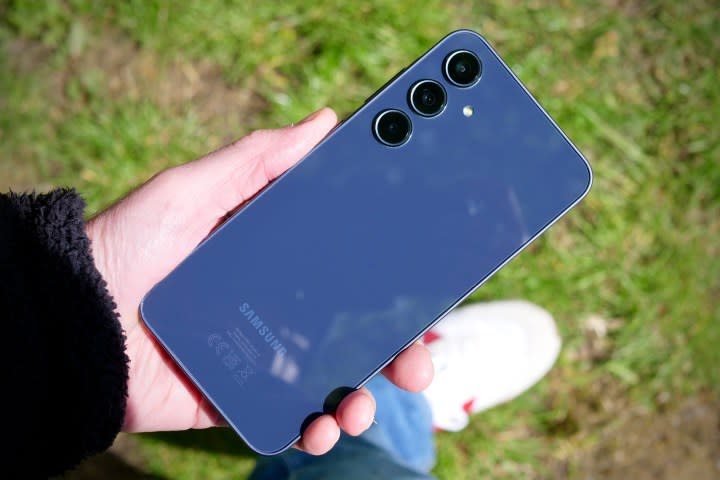
Samsung Galaxy A35
The best cheap phone runner-up
Pros
Light and comfortable to hold
IP67 rating makes it durable
Main camera takes fun photos
Long software update commitment
Cons
Battery doesn't last two days
No wireless or fast charging
Why you should buy this: The Samsung Galaxy A35 has the flagship looks and features without the flagship price.
Who it’s for: Anyone who wants a phone that looks like Samsung's flagship S24 and has good performance — but for half the price.
Why we picked the Samsung Galaxy A35:
The Samsung Galaxy A35 offers a lot of flagship features for less. For the most part, it looks and feels like the Galaxy S24, with a few minor modifications, like the raised section on the side of the phone for the volume and power buttons. But the camera module looks the same as the S24, so you could mistake it for the higher-end S24 from a distance.
The Galaxy A35 is slightly bigger than the S24 with a 6.6-inch Super AMOLED display, and it even has a 120Hz refresh rate on the screen. This means scrolling through the system and apps and playing games is smooth and easy on the eyes, and the colors are vibrant and rich with deep blacks.
Though the chassis is made of plastic, the screen has Gorilla Glass Victus Plus, so it's quite durable, and it has an IP67 rating. The phone feels nice in the hand, and the increased brightness to 1,000 nits makes it easy to see when outdoors.
You get a 50MP main camera with optical image stabilization (OIS), as well as a 8MP wide-angle camera and a 5MP macro lens. The front-facing selfie camera is 13MP. Photos that are taken with the A35 will appear bright, colorful, and vibrant. However, as Samsung typically oversaturates colors, sometimes the primary colors may have a little too much punch to them, as it's over amplified. But photos with the ultrawide lens may appear a little bit dull and washed out due to the lower megapixel count. Thankfully, there are plenty of tools in the photo-editing suite to change up your photos if need be. The selfie camera is pretty average, and good enough to capture a quick selfie every now and then.
Samsung put its Exynos 1380 processor inside, with a minimum of 6GB RAM that is configurable up to 12GB, and 128GB or 256GB storage, plus you have a microSD card slot. While the Exynos 1380 chipset may not be as fast as the new Snapdragon 8 Gen 3 in the S24 series, it's still reasonably fast and performs well for the price. It comes with Android 14 and One UI 6.1, which is the same as the S24. Samsung promises software upgrades for the next four years, with five years of security updates.
Though the Galaxy A35 has a 5,000mAh battery inside, it won't get you through two consecutive days without a charge overnight. That said, it should last most of the day if that's all you need. It charges at a maximum speed of 25W, and unfortunately, there's no wireless charging.
Samsung Galaxy A35
The best cheap phone runner-up
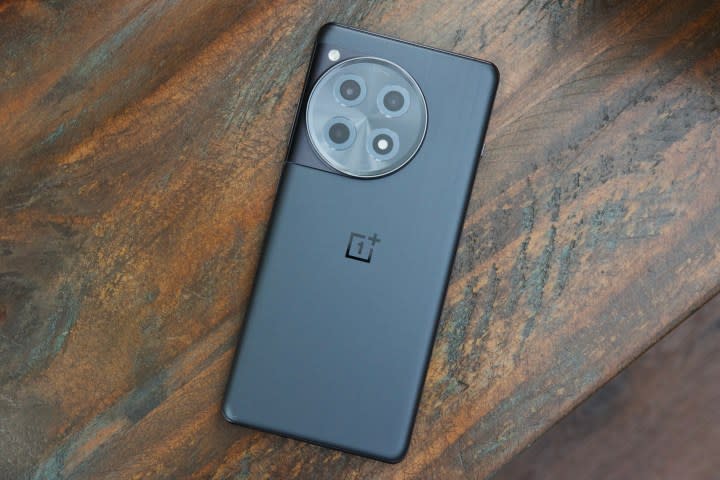
OnePlus 12R
The best phone value
Pros
Sleek, polished design
Top-notch display
Fast performance; runs cool
Excellent battery life
80W charging!
Unbeatable price
Cons
Poor ultrawide and macro cameras
No wireless charging
Why you should buy this: It's a true flagship killer, offering flagship specs on a budget.
Who it's for: Anyone who loves getting great value from their money.
Why we picked the OnePlus 12R:
Love the OnePlus 12 but don't really want to spend $800? The OnePlus 12R is worth taking a look at instead. It brings in a lot of what makes the OnePlus 12 great — including strong specs, a unique design, and Oxygen OS — but at a much lower price. This is the best value you'll get on the phone market in 2024 by a long shot.
The design is reminiscent of the OnePlus 12 and 11, with a sleek but slippery aluminum body and a very distinctive camera suite that makes the phone stand out. The display is a little odd, with a 2780 x 1264 resolution across the 6.78-inch AMOLED display, but thanks to the ppi of 410 and a 120Hz refresh rate, it's fast and crisp enough that you're not likely to care about the odd numbers at play. Like the OnePlus 12, it also tops out at 4,500 nits for brightness.
The flagship killer credentials are provided by the flagship specs. The Snapdragon 8 Gen 2 processor is last year's chip, but it's still incredibly powerful and provides exceptional performance. Add in 8GB or 16GB of RAM and 128GB or 256GB of internal storage. A cooling chamber inside further bolsters the strong hardware, and ensures the phone runs cool even when playing demanding games.
The camera is more of a mixed bag than its more expensive cousin. The 50MP main lens is good, but the 8MP ultrawide lens is a bit of a disappointment, and the less said about the 2MP macro lens, the better. Thankfully, the 16MP selfie lens is a good inclusion, and it means the camera system is a good one, even if it's not the most versatile around. It's more than acceptable for $500, even if it is massively outpaced in this regard by similarly priced options like the Samsung Galaxy A54 or Google Pixel 7a.
The battery is another return to glory, and even if there's no wireless charging, wired charging up to 80W means few will care. Moderate use will have this be another two-day smartphone, and even four and a half hours of screen time (demanding by most measures) left the phone at 43% at 11:25 p.m. after a long day. That's a stellar performance and a genuine reason to buy this phone.
The OnePlus 12R is a true cut-price king. At $500, it has some strong competition from Samsung and Google, but they generally can't match the sheer oomph offered by the 12R's Snapdragon 8 Gen 2 and other flagship specs. OnePlus's midrange phone is the phone to get if you prize value above all else.
OnePlus 12R
The best phone value

Apple iPhone 15 Plus
The best big iPhone
Pros
Ergonomic design
Big, bright, colorful screen
Inspiring camera
Two-day battery life
USB C and MagSafe for charging
Cons
60Hz refresh rate screen
No always-on display
Not the latest processor
Why you should buy this: It packs a huge, stunning screen, it feels substantial, and the design won't fail to impress.
Who it’s for: Anyone who wants the best big-screen iPhone around for less.
Why we picked the iPhone 15 Plus:
The iPhone 15 Plus is almost identical to its smaller counterpart, the iPhone 15, except for its larger display. The 6.7-inch smartphone is beautifully designed and is available in pink, blue, black, yellow, and green. USB-C, which is faster for file transfers, is included in the iPhone 15 series, replacing the Lightning port. However, there have been no improvements in terms of charging. The battery life still lasts for two days, which is quite impressive.
Another feature the new phone boasts is the Dynamic Island, which was initially introduced in the iPhone 14 Pro models. This feature provides a fun way to view notifications, Live Activities, and more.
In terms of camera capabilities, the iPhone 15 Plus is highly impressive. Thanks to the depth-of-field feature, the phone can capture well-balanced, dynamic, colorful, and enjoyable photos. The new cameras and features are a significant upgrade from previous standard iPhones, and it’s great to see that the iPhone 15 Plus is not just limited to taking casual pictures, but also has the potential to enhance your creativity.
Unlike the iPhone 14 Plus, which felt out of place in the iPhone lineup, the new Plus model is a perfect fit. Ergonomic improvements have made a significant difference, the performance has been dramatically improved, and the cameras inspire one to take more photos.
On the downside, the iPhone 15 Plus still offers a low refresh rate of 60Hz, and it features last year’s A16 Pro chip. Nonetheless, it's a great option if you're looking for a large iPhone at a lower price point.
Apple iPhone 15 Plus
The best big iPhone

Apple iPhone SE (2022)
The best small iPhone
Pros
Compact and light
Very powerful
Touch ID works really well
Wireless charging
IP67 water resistance
Cons
Poor battery life
60Hz screen
64GB won't be enough
Why you should buy this: Apple's latest iPhone SE (2022) is a pint-sized wonder that's powerful, affordable, and future-proof.
Who it’s for: Those looking for a future-proof phone that fits in their pocket (and their hand).
Why we picked the Apple iPhone SE (2022)
Finding a truly small phone today feels like hunting for a needle in a haystack, but the iPhone SE (2022) is really, truly small, with its tiny 4.7-inch Liquid Retina display with 60Hz refresh rate. Sadly, the design feels a bit dated, cribbing the iPhone 8's design, with chunky bezels and a Home button with integrated Touch ID.
Looking beyond its size, there's a lot going for the iPhone SE. Under the hood, you're getting Apple's A15 Bionic chip with the same performance spec as the iPhone 13 Pro. There's also 4GB of RAM, 64GB, 128GB, or 256GB of storage, and a decent battery, though heavy use may see you struggle to make it through the day with much left in the tank. You'll be up and running fairly quickly with 18W fast charging and Qi wireless charging.
You also get a single 12MP rear sensor and 7MP selfie camera, identical to the previous iPhone SE. But it's Apple's software that makes a difference here, with Deep Fusion technology, Smart HDR 4, and Photographic Styles, as well as improved Portrait Mode. There's no Night Mode though, so shooting in low-light environments can be a challenge.
Add 5G connectivity, iOS 15 out of the box, and five or six years of OS updates, and it's easy to see why the iPhone SE (2022) is our best small smartphone. Yes, the design feels a bit old-fashioned, those bezels are pretty clunky, and there's no charger in the box — but now we're nitpicking. The iPhone SE (2022) comes priced at an incredible $429, so you won't need to break the bank to afford it.
Apple iPhone SE (2022)
The best small iPhone
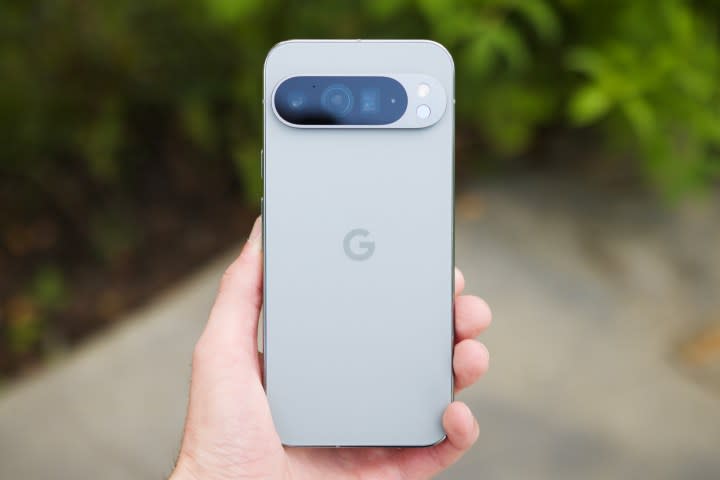
Google Pixel 9 Pro XL
The best big Android phone
Pros
Google's best Pixel hardware yet
Excellent display
16GB of RAM!
Really fantastic cameras
Helpful AI tools
Much better battery life
Seven years of updates
Cons
Pixel Studio is a mess
Slow charging speeds
128GB of base storage
Why you should buy this: It's the biggest Pixel 9 phone you can buy that isn't a foldable.
Who it's for: Someone who wants an outstanding Android smartphone with a huge display.
Why we picked the Google Pixel 9 Pro XL: It's the best Android-based phone with a huge display.
For the first time since 2019, Google has revealed a Pixel XL model. The Pixel 9 Pro XL is the spiritual successor to last year's Pixel 8 Pro, and it doesn’t disappoint. In fact, it’s an absolute game-changer.
This stunning masterpiece from Google redefines what a flagship smartphone should be. With its gorgeous flat frame, redesigned camera bar, and impeccable build quality, the Pixel 9 Pro XL is a true work of art.
But it's not just about looks. Under the hood, this beast packs a punch with the powerful Tensor G4 chip, a mind-blowing 16GB of RAM, and Google's unparalleled camera prowess. From stunning low-light shots to crisp ultrawide angles and impressive zooms, the Pixel 9 Pro XL's camera setup will leave you in awe. And with AI features like Auto Frame and Add Me, your photos will be picture-perfect every time.
But that's not all! The Pixel 9 Pro XL also boasts an outstanding 6.8-inch Super Actua Display, delivering vibrant colors and buttery-smooth performance. It also has a much improved battery life and fast charging capabilities to keep you going all day (and night) long.
We have a few concerns regarding this phone. Firstly, we found Pixel Studio to be disorganized. Secondly, the overall charging speed was slower than expected based on the specifications. Lastly, the minimum amount of storage is only 128GB. In the future, we hope that Google and other vendors begin offering smartphones with a minimum of 256GB of storage.
The Google Pixel 9 Pro XL is truly a masterclass in smartphone engineering, setting a new standard for big flagship devices.
Google Pixel 9 Pro XL
The best big Android phone

Samsung Galaxy S24
The best phone value runner-up
Pros
Small and compact design
The flat edges are great
Beautiful and bright display
Long lasting battery life
Powerful performance
Improved color balance in photos
Useful Galaxy AI features
Cons
Matte glass feels slippery
No big camera upgrades
Only 25W wired charging
Why you should buy this: It's everything great about the Galaxy flagship range, but cheaper.
Who it's for: Anyone who wants a powerful Android but prefers a cheaper phone.
Why we picked the Samsung Galaxy S24:
It's unsurprising that the standard Galaxy S24 is the smallest of the three flagship phones that Samsung released this year. The 6.2-inch LTPO AMOLED display with 2600 nits peak brightness is 0.1 of an inch larger than the S23, but due to Samsung shrinking the bezels, the S24 is slightly narrower than last year's model, though it is slightly taller as a result. As with the S24 Plus, the display is a delight to behold, with a dynamic 1-120Hz refresh rate and 2,600 nits of brightness. Unfortunately, it's still limited to a 1080p resolution, but you can't have everything.
The Snapdragon 8 Gen 3 is as powerful as we've seen elsewhere, and the smaller phone has more modest but still powerful specs, including 8GB of RAM and 128GB of storage as standard. The battery is still good, but the 4,000mAh cell can't go as far as the S24 Plus and will only last a day. It's a solid full day, though, and you'll generally have a decent amount left in the tank, just not enough to last a full second day. Charging is disappointing, too, being limited to just 25W. The 45W charging included on the Plus and Ultra models means the S24 feels underwhelming.
The original price of the Samsung Galaxy S24 was $800. However, since it’s a bit older now, it’s typically available at a lower cost. Its value proposition is impressive. While it may not be as powerful as the OnePlus 12 or have the camera capabilities of the Google Pixel 9, the Samsung Galaxy S24 still competes well against them. Additionally, it is small and compact, which is uncommon in most modern, powerful phones.
Samsung Galaxy S24
The best phone value runner-up

Google Pixel 9
The best small Android phone
Pros
Excellent design and build quality
Super camera
Tactile haptics
Fast and reliable security
Improved efficiency and battery life
Long software update commitment
Cons
Screen isn't always bright enough
Slow charging
More expensive than last year
Why you should buy this: It's an impressive "regular" phone many people want to buy.
Who's it for: Anyone who wants to spend a little bit less, but still get most of the advanced smartphone features.
Why we picked the Google Pixel 9:
The entry-level Google Pixel 9 offers a lot of great features for folks looking for an impressive Android phone — and it's priced less than many other models on the market.
Our reviewer raved about the Google Pixel 9 as a device that genuinely impresses on all fronts, from its stunning design to its exceptional camera quality. While Google initially emphasized the phone’s AI features, the hardware steals the show with its combination of elegance and functionality.
The Pixel 9 is a stunning device with its sleek metal frame and elegant glass back in vibrant colors that catch the eye effortlessly; however, it’s not just about appearance. The exceptional build quality gives it a premium touch and feel.
The camera is truly amazing. It takes vibrant photos that will make your social media posts stand out. Whether you're taking pictures of scenery or people from all angles, the Pixel 9 takes stunning shots. Sure, it lacks a telephoto lens like the Pro model, but its images are just as good.
The standout feature of this device is its battery longevity and lightning-fast speed, thanks to its impressive Tensor G4 processor. It effortlessly handles whatever you throw at it. The AI capabilities are also impressive.
The Pixel 9 stands out as a designed smartphone that excels in the essentials. Priced at $799, it presents an option for individuals looking for a high-end Android experience in a compact form factor.
Google Pixel 9
The best small Android phone
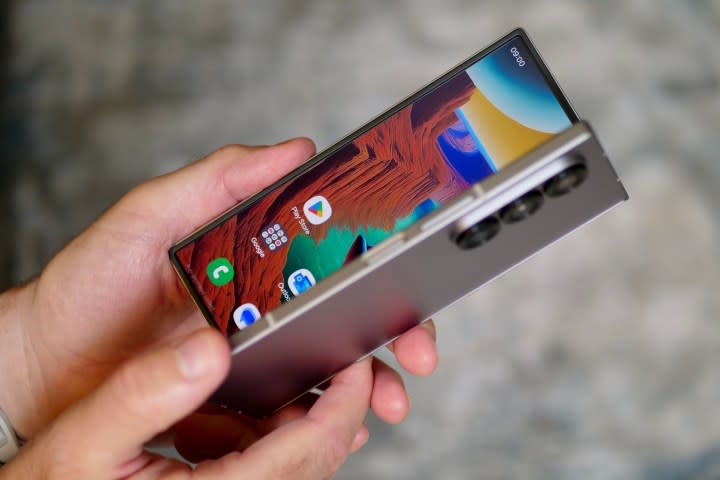
Samsung Galaxy Z Fold 6
The best foldable phone
Samsung Galaxy Z Fold 6 Review
Pros
Fantastic folding design
Refined size and weight
IP48 water and dust resistance
Two colorful, usable screens
Main camera takes fun, vibrant photos
Long software commitment
Cons
Slow battery charging
One-day battery life
More expensive than last year
Why you should buy this: Folding phones are the future, and the Galaxy Z Fold 6 is the most powerful foldable around to date.
Who it’s for: Anyone looking for a powerful phone in a foldable form factor.
Why we picked the Galaxy Z Fold 6:
Samsung's new Galaxy Z Fold 6 costs a whopping $1,900. But before you write it off, remember a few things.
This folding marvel continues to refine and perfect the foldable phone experience. The tweaked dimensions and weight (versus the Galaxy Z Fold 5) make it more comfortable to use one-handed when closed, while the large 7.6-inch inner screen is perfect for gaming and media.
While not a significant upgrade from the previous model, Samsung has fine-tuned the hardware to minimize previous pain points like the crease and durability concerns. The cameras aren't on the level of phones like the Google Pixel 9 Pro or Galaxy S24 Ultra, but they're still very good.
The biggest letdown? That hefty price tag for relatively modest upgrades. But if foldable phones fascinate you, the Z Fold 6 represents the current pinnacle of this innovative form factor. If you're willing to invest in cutting-edge technology and experience the latest foldable phone innovation, the Galaxy Z Fold 6 might be the perfect choice.
Samsung Galaxy Z Fold 6
The best foldable phone
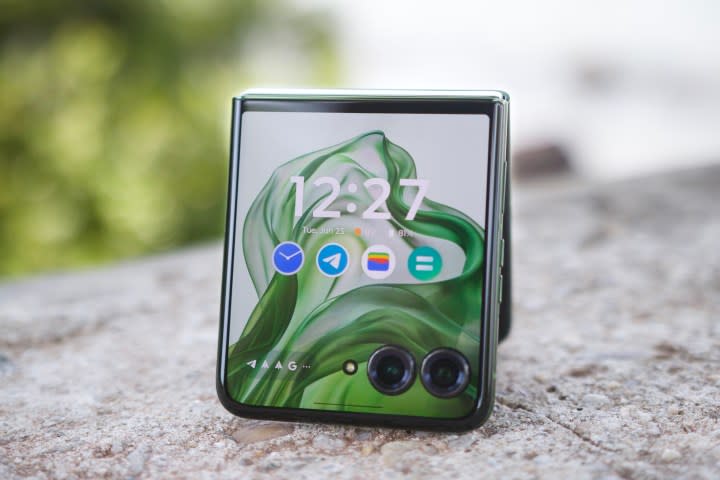
Razr Plus (2024)
The best flip phone
Motorola Razr Plus 2024 Review
Pros
A smooth, durable hinge
Lovely leather back
Fantastic cover screen
Much-improved cameras
Reliable battery life
Ample charging options
Fun and charming software
Cons
Tinny speakers
Three years of OS upgrades
Why you should buy this: It looks great, boasts fast performance, and has a fun and foldable form factor and bespoke colors.
Who it’s for: Anyone looking for their first foldable who prefers a more compact flip design.
Why we picked the Razr Plus (2024):
Say hello to the Motorola Razr Plus 2024 — the folding phone that has it all, and has leapfrogged the Galaxy Z Flip 6 to get onto this list. This phone is beautiful with its sleek leather back, buttery-smooth hinge, and eye-catching colors.
But it's more than just good looks. The Razr Plus 2024 packs a fantastic 4-inch cover screen (yes, you read that right), letting you stay in the loop without unfolding. A gorgeous 6.9-inch inner display awaits when you unfold it with vibrant colors and silky smooth refresh rates up to 165Hz.
Cameras are a major upgrade, too — snap drool-worthy shots with the 50MP main camera, get up close with the 2x telephoto lens, and say goodbye to blurry pictures thanks to OIS. Plus, that big cover screen doubles as a viewfinder for the ultimate selfie experience.
Performance? Battery life? Charging speeds? The Razr Plus 2024 checks all the boxes. And let's remember Moto's delightfully whimsical software that adds a fun touch to your daily grind. Our only major complaints about this phone are its tinny speakers and the fact that Motorola provides only three years of OS upgrades, which compares unfavorably to the seven years offered by other manufacturers.
Overall, however, this is a premium foldable that genuinely delivers. The Razr Plus 2024 is the flip phone to beat this year.
Razr Plus (2024)
The best flip phone
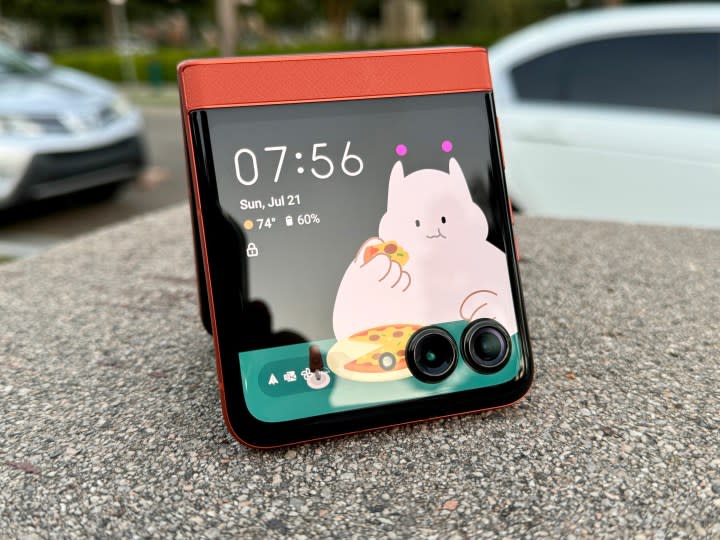
Motorola Razr (2024)
The best cheap folding phone
Pros
Super-compact design
Large cover screen with always-on display
Improved hinge design
Good cameras
Long battery life
Crease is very minimal
Fun colors
Cons
Ultrawide camera isn't the best
Only three years of OS upgrades
No reverse wireless charging
Why you should buy this: Not everyone desires all features on a flip phone. If that’s you, this is the one you want.
Who's it for: Anyone who wants a no-hassle smartphone experience.
Why we picked the Motorola Razr (2024):
The future of foldables is here, and it's a steal. The new Motorola Razr 2024 is a game-changer in foldable phones. At just $700, it's an incredible value that packs a serious punch.
This clamshell beauty turns heads with its gorgeous 6.9-inch foldable display, super-compact design, and fun color options like Spritz Orange. But it's not just a pretty face — the Razr 2024 boasts impressive specs like a large 3.6-inch cover display, great cameras, and strong battery life.
If you’re seeking drawbacks of this phone, they do exist. Unfortunately, the Razr 2024 only includes three years of OS upgrades. In addition, it lacks reverse wireless charging and the ultrawide camera performance is subpar. Nonetheless, Motorola nailed the foldable experience without breaking the bank. Whether you're a foldable fan or want to try something new, the Razr 2024 is a must-have!
Motorola Razr (2024)
The best cheap folding phone
Frequently Asked Questions
Which operating system is best for you?
There are two major players in smartphone operating systems: Apple's iOS, and Google's Android. Picking between them is going to form a big part of your smartphone choice, right? Sort of.
Apple's iOS and Google's Android are completely separate systems, so any apps or games you buy on one will not transfer over to the other. If you're heavily invested into one or the other already, that should play a part in whether you want to buy a phone running the other OS. But don't let it put you off entirely: Most of the apps you'll find on one, you'll also find on the other, and even if your purchases won't transfer over, you'll still be able to to find the same general experience from the free apps you use.
Apple's iOS is definitely the more unified experience. Since only Apple makes devices that use iOS, it decides how it looks, feels, and functions — down to the very last transition. Android is a lot more fluid and dynamic. While Google has its own design choices, other manufacturers are free to change the look and feel as they prefer by creating what's commonly referred to as a "skin." Samsung's One UI is probably the best known of these. While this has its advantages, sometimes these changes can make a phone feel drastically different. Sometimes this is better, sometimes it's worse. While you always know what you're going to get with iOS, Android can be a bit more of a mixed bag.
Software updates are hit by this same dynamic. Apple's control means it can push out updates on day one or two of a new patch or iOS version being available. Google can do that for its own Pixel devices, but updates to phones made by Samsung, Nokia, OnePlus, or other manufacturers will take longer — largely because each company will have to make sure the update works with its own skin or software. As a result, it can be anywhere between weeks and months before some Android phones get updated to the latest version of Android. This can be important when updates contain bug fixes or security patches, and even if those are pushed through as a priority, they'll still be landing later than they would on iPhone.
Ultimately, while there are differences between the two operating systems, there are far more similarities when it comes to Android and iOS. Both have largely the same selection of apps and games, and the day-to-day experience is much the same. While there definitely are differences, swapping to Android from iPhone (or vice versa) won't leave you confused.
Can smartphones get viruses?
While it is possible to get viruses on iPhones or Android phones, what most people mean when they say "virus" is malware. Technically, the term virus means software that infects a host, inserts itself into an existing program, and then spreads that infection by self-replicating. They are a very small percentage of malware and extremely rare on smartphones, but malware isn't. You should definitely think about how to protect your smartphone from hackers because a little common sense can save you from having to work out how to remove malware from your phone.
What is an unlocked smartphone?
A locked smartphone is tied to a specific carrier's network, so if your phone is locked to Verizon, for example, you can only use it with a Verizon SIM and service plan. An unlocked smartphone can be used on any network. If you've paid in full for your phone, then it should be free to unlock. We have a guide that will show you how to unlock a phone on every carrier. You can also buy some great unlocked phones that will work with any carrier straight out of the box.
How long should a smartphone last?
Realistically, you should expect to get two to three years out of your smartphone. You can extend the life of any smartphone by taking proper care of it and it's always worth shopping for good protective cases. There are also loads of good waterproof phones to choose from nowadays. The problem with many Android phones is that manufacturers and carriers are slow to push out software updates, so the software can become dated and even insecure over time. With that said, Samsung recently set new standards for updates, promising seven OS updates and seven years of security updates on select Galaxy devices including the Galaxy S24 and Z Fold 6 series, and four upgrades and five years of security updates on the Z Fold 5 and Z Flip 5, and predecessors the Z Flip 4 and Z Fold 4. Apple is also known for its lengthy updates promise, while Google now offers seven years of Android OS updates and security updates for the Pixel 9 and Pixel 9 Pro.
How do prepaid phones work?
Prepaid cell phones work just like any other phone, but they come without a monthly contract or long-term commitment. You usually pay for service in advance. When you buy a prepaid phone they tend to come with a fixed number of minutes, text messages, and possibly a fixed amount of mobile data. This removes the chance of any overage charges. When you run out, you simply top up by buying more minutes, texts, and data in chunks.
What should I do with my old smartphone?
The most obvious thing to do with your old smartphone is to pass it on to someone else. If you want to gift it, then make sure to wipe it first; we have guides on how to wipe your Android phone and how to factory reset an iPhone. You may also want to turn that old phone into cash, in which case you'll want to read up on how to sell your smartphone. You may decide to keep it as a spare in case your new smartphone breaks, but you could also repurpose it with the right apps. It's better to pass it on to someone who can use it or find another use for it than let it languish in a drawer. If you can't think of a good way to reuse your smartphone then consider donating it or recycling it.
If you still haven't found what you're looking for, then we also have ideas about the best rugged phones, best phones for kids, and the best gaming phones.
How we test
A phone is so much more than its spec sheet. Your entire life is stored on it, from your photos and contacts to your music and your favorite apps. For that reason, we take great care when we review phones to recommend only the absolute best out there.
We use each phone we review as our daily driver for an extended period to test out all the features. We do benchmarks, play games, take photos, plunge them in water, and use them until their batteries expire. Then we charge 'em up and do it all over again. We test devices like real people use devices. We're not in some stuffy lab performing obscure tests. We're running around the cities we live in using these phones just like you use your phones. Then we think about each phone in comparison with its competitors to come to a decision: Should you buy this phone or something else? If the answer is "something else," we tell you what to buy instead.
Smartphone innovation has peaked, and the number of radical new features that come out each year is shrinking. As such, when you're buying a phone, you're buying a device that will be with you 24/7 for several years. It's a big choice, and things like apps, a product ecosystem, customer support, and security should be important factors in your buying decision.
